PhD student Fowee's love for aerospace fostered by father
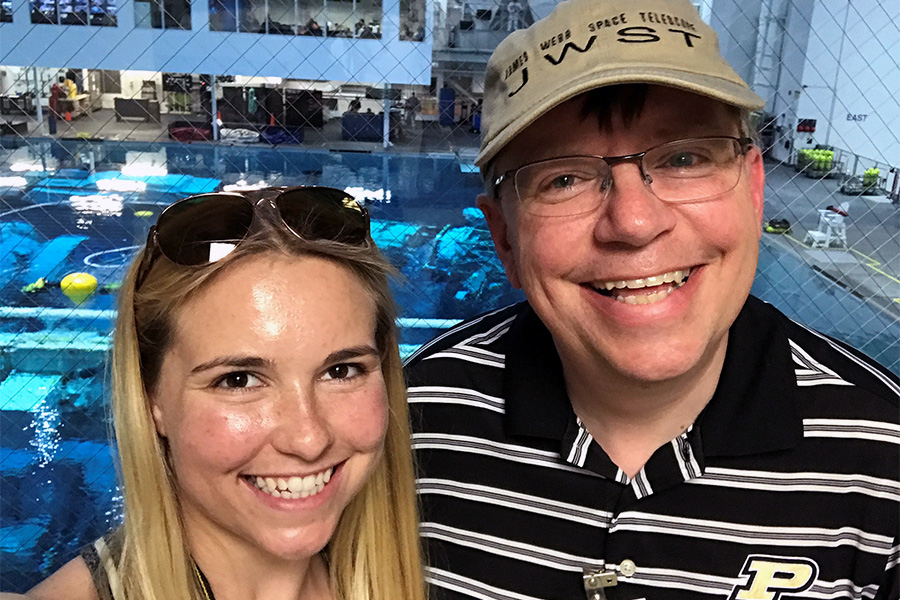
They all, seemingly, were enchanted.
A certain special visitor to a preschool housed at an engineering company meant talks of the space shuttle and the Apollo program with props.
The storyteller, decked out in a space-themed necktie and clutching a model rocket, was passionate, regaling kids with mission details, sharing the successes of Moon landings and triumphant astronauts.
He never seemed to notice the girl in the front, the 5-year-old with shaggy blonde hair, appearing like she didn’t want to be there. Maybe a bit of her attitude was from embarrassment, her dad was the one who was speaking. Maybe a bit was ennui, because she had heard it all before.
Roger Fowee may have been a chemical engineer for Nalco, an Ecolab Company, but his love for all things aerospace engineering always was on display.
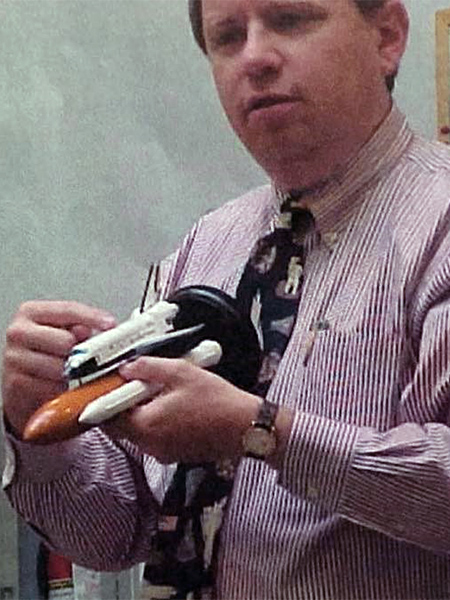
So daughter Kate already had garnered extensive time playing with to-scale models of Saturn V and Redstone that he had in his office at work, or the Lunar Excursion Module he had on a bookshelf at home in a Chicago suburb. He had spent nights reading her stories from the space-themed books that lined those shelves. He had filled car rides with chatter of spacecraft and missions.
Maybe Roger Fowee wasn’t intentionally trying to breed an aerospace engineer back then. Maybe it really was just a dad sharing a love for a subject with his only kiddo, especially once he realized her interest was piqued.
But, nearly 20 years later, that’s what he has gotten.
Kate earned a bachelor’s degree in aeronautics and astronautics from Purdue in 2016, tacked on the master’s last May and currently is working on her doctorate.
And though she’s made her own choices leading to this point, flirting with chemical engineering during her first year of engineering at Purdue before choosing AAE, Dad’s ongoing influence did play a role in her career path. And ultimately helped mold a special, award-winning student with a desire for developing solutions to help further our understanding of the universe by engineering the hardware for conducting and studying science in space.
“My dad is one of the biggest nerds I know, and he loves everything about aerospace. I know he was super excited when I said I wanted to do aerospace engineering,” Kate says. “It’s just nice to have that to share with him. It always makes me feel good that he gets really excited about it, too.”
Roger explains his interest in aerospace simply by “it was the right time growing up.”
As a child in the 1960s, with the Gemini program up and running and Apollo missions to follow, he learned about human spaceflight and watched launches and crewed missions, including Purdue aeronautical engineering graduate Neil Armstrong’s first steps on the Moon in 1969.
Roger was enamored with aerospace, but his father Bill was in the chemical industry. So Roger was exposed to chemistry as a kid, too, and he enjoyed that. Purdue became Roger’s college destination after Bill mentioned how impressed he was with Purdue students who did co-ops at Procter & Gamble, the company where Bill worked. That was enough to push Roger from Cincinnati, Ohio, to West Lafayette, Indiana.
When Roger stepped foot on Purdue’s campus to register in the early 1980s, it was his first visit. The blind-faith decision, as Roger calls it, worked. He left Purdue with a bachelor’s degree in 1985 and headed to work as a corporate scientist for Nalco in Naperville, Illinois. And he brought someone with him: Diana, a metallurgical engineering major.
Eight years after they were married, Kate was born. In the delivery room, Roger and Diana talked about how Kate would be a Boilermaker, like them. But what she’d become professionally, that still was well to be determined.
 900.jpg)
Dad, simply, started to share his interests. Because Diana’s brother Thomas A. De Maeyer — also a Purdue graduate — was a commercial pilot, Roger’s aerospace information sessions with Kate weren’t strictly about space either.
“One of the awful things about chemistry and chemical engineering is it’s very hard to make it conceptual and real early on,” Roger says. “You can look at an airplane. You can look at a rocket. It’s very easy to get your hands around how cool it is. A chemical reaction, you can’t do that. You see a refinery, OK, it’s a bunch of pipes, but you can’t make that dramatic to a child. So when you’re trying to explore something that’s interesting, I just think (aerospace) is something you can get them excited about science and they can relate at the very earliest of ages.
“I had so much background and history, it was easy to tell her.”
So he did. Frequently.
Kate knows most of the Apollo astronauts because her dad would go through the list when she was little, making sure to mention which were Purdue alums. (There were many then, and the list keeps growing with AAE’s Loral O’Hara an astronaut in-training now, pushing the total to 24.)
The home library was a common meeting place, so when Kate had Roger pull the Lunar Module off the shelf to play with, he also could explain to her what filled his extensive book collection. It was not just biographies of astronauts and the like. Many books had an engineering bent, technical and specific, like a manual about the control system of the Apollo and how it was developed.
When a space shuttle launched or landed, Roger tried to make sure to pull Kate aside to watch it on TV. That included on Feb. 1, 2003. After the Space Shuttle Columbia broke apart upon reentering Earth’s atmosphere, killing its seven crew members, Roger and Kate sat in front of the TV the entire day to watch the coverage.
When Kate was in high school and started seriously considering aerospace engineering as a future, Roger told her she had to watch any relevant space-related movie or documentary. They savored the 12-part HBO series, “From the Earth to the Moon.” It was special because each episode broke down a different piece of the Apollo mission, whether it be from an astronaut’s perspective, a family’s perspective, or, even, the engineering perspective.
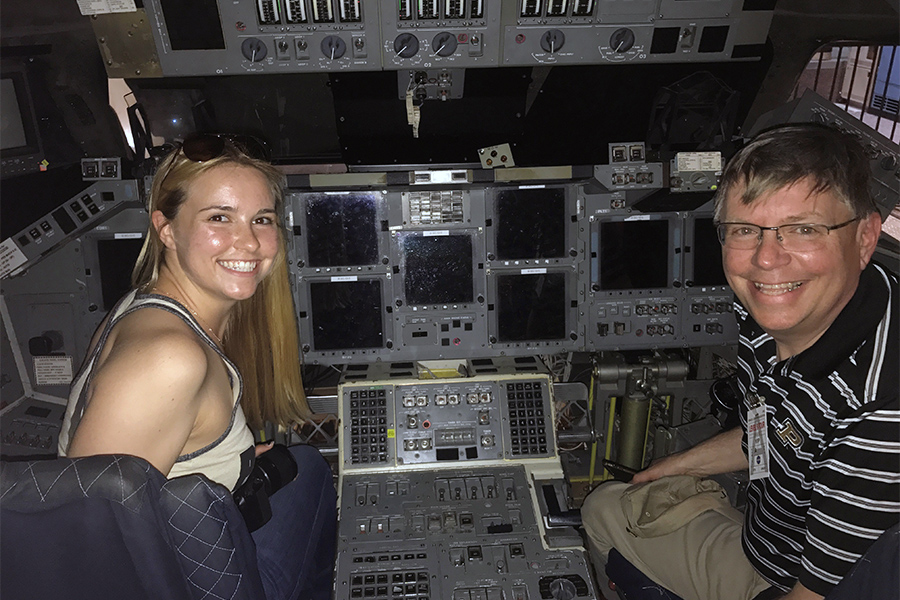
“She just loved it,” Roger says. “She didn’t maybe necessarily watch it 20 times in a row like a Disney movie when she was 5, but she was repetitive and could really enjoy it and relate to it.”
That was after she’d grown up watching the TV series “Nova,” a show on PBS that explored science topics. Kate was intrigued by astronomy and physics but remembers particularly enjoying episodes on string theory.
“I don’t know if it was about the particle accelerators and the universe-is-weird stuff, learning about special relativity and general relativity, but I thought that was so interesting,” she says. “Somehow that manifested itself with knowing all the stuff I knew about space (that), ‘Oh, hey, you can be a little bit more practical and do engineering stuff for solving those problems.’ I didn’t know that’s why I liked it until a few years ago when I got to do an internship on James Webb Space Telescope. That’s where it clicked.”
Plenty clicked once she chose Purdue.
Though her parents told her to apply to others schools — and she did — there really was little doubt Purdue would be the destination. Part of that was because she wanted to play Division I soccer. But part was because “this feels like home, always has,” she says.
A home that’s offered incredible opportunities. And not just for her.
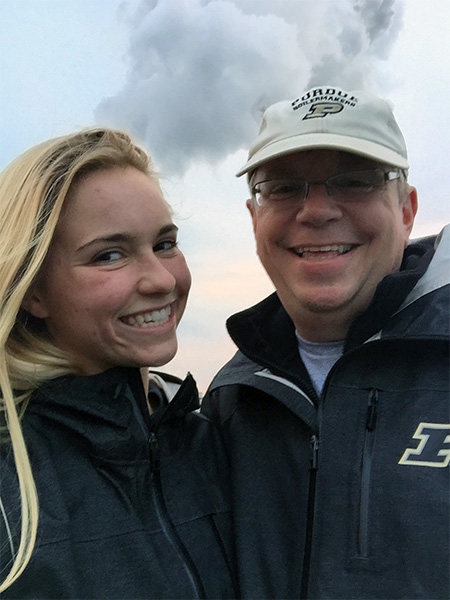
The SURF program got her into research mode and ultimately connected her with professor Alina Alexeenko, Kate’s current advisor, working on a cold gas thruster project. Now, she is helping design a water propulsion system for CubeSats.
Two internships with Northrop Grumman allowed her to work on the F35 and, then, the James Webb Space Telescope.
A connection with then-professor Dan Dumbacher offered a trip to watch the launch of Exploration Flight Test-1 — the first test flight of the Orion Multi-Purpose Crew Vehicle — on the Delta IV Heavy in December 2014. But not alone. She got a plus-one, and, naturally, asked Dad. So they made the trip to Kennedy Space Center in Florida. On launch day, they woke up at 1 a.m. and hopped on a bus to get to the launch site before 3. But the first launch was delayed, so they made a second trip to the causeway at Cape Canaveral the next morning.
“That was a really awesome experience to share with him,” Kate says. “It still comes up. Something will launch and he’ll be like, ‘By the way, we saw a rocket launch. You remember that?’ I’m like, ‘Yeah, Dad, I remember.’ ”
Says Roger, “That was a great moment with her. That was just amazing. That would be a highlight.”
Another: When Kate was chosen as one of Aviation Week’s “Tomorrow’s Technology Leaders: The 20 Twenties,” she invited Dad to the awards ceremony in Washington D.C. Roger had done his research and knew Peggy Whitson, the astronaut who had spent more time in space than any other American at the time she retired in June, was going to be honored with a lifetime achievement award at the event. Kate even had picked up a copy of National Geographic at the airport with Whitson, at Roger’s request. “It’ll be so cool to see her on stage,” Roger told Kate. But he got something much better. While walking to a luncheon before the official banquet that night that included the 20 Twenties honorees, Roger spotted Whitson exiting a car in front of the restaurant. He freaked out a bit.
“My dad is like, ‘That’s her! She’s going to be at this lunch?!’” Kate says, laughing. “I’m like, ‘Dad, calm down. She’s still a person.’ We ended up sitting at the same table with her at lunch. I tried to make that happen, actually, for my dad. He really enjoyed that lunch. He was very excited to meet an astronaut.”
It doesn’t have to be an astronaut encounter for Roger to get emotional.
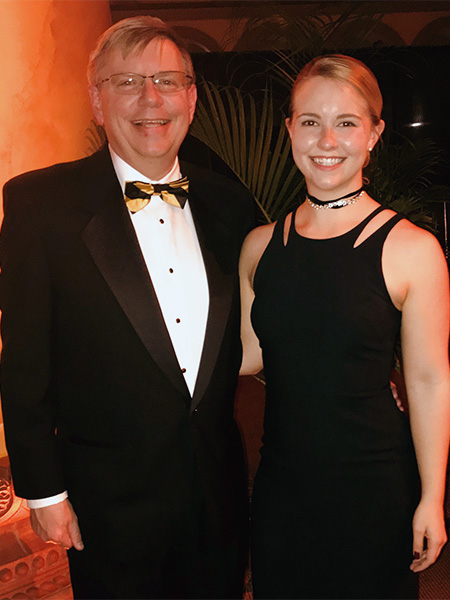
He’s made it a point to take vacations with just Kate over the years — Diana does the same thing with her daughter — specifically to potential professional destinations. That meant a recent trip to Houston for NASA’s Johnson Space Center. They got the best tour available, and it included visiting the Neutral Buoyancy Lab where astronauts are trained for spacewalks, a glimpse at the original mission control, and, even, a chance to sit inside a shuttle simulator. At one point in the tour, Roger turned to Kate and told her how proud he was of her and how happy he was to share these experiences.
“It’s kind of fun to geek out with your kid doing stuff you wish you could have done and that she relates to and understands intellectually,” Roger says. “It’s just neat to be in the middle of it all.”
Not just on trips, though. Kate has made sure Roger is in the loop on her day-to-day life at Purdue, too. Because he’s an engineer, they can speak generally the same language.
During the second semester of Kate’s master’s work, she needed to write a literature review that wasn’t on her actual research topic for a combustion class. Knowing her dad works with systems that do heat and combustion — it may come up, time to time, that he’s a Boilermaker who works on boilers — she figured she’d ask him for suggestions. He offered articles to read and helped her come up with a topic.
He was able to listen in on her master’s defense, an experience he called “so cool.”
Every morning when she gets the daily email from the AIAA, Kate will read through the headlines and offer up a one- or two-word synopsis of articles she thinks are interesting and forwards it to Roger. He’s especially interested in SpaceX news, as he watches every live launch the commercial space company shows on social media and, in real time, offers a play-by-play to Kate via text.
Her research means spending time in the clean room at Birck Nanotechnology Center, where she may feel closest to her dad because she actually mixes chemicals there. She makes sure to call him every time she leaves the building, filling him in on what she worked on and, in part, to reassure him that she’s OK after dealing with lethal acids.
“There’s a lot of fascination to learn things and how things work that we overlap well on,” Rogers says. “I’m hoping we will always stay close. It’s going to get less at some point, as more things come into her life. When she gets married, she has kids, things will change. But right now, it’s pretty cool. Everything she’s doing professionally now, there’s nothing really secret that she does, so she can share. Eventually, it’ll come that things are protected so you can’t quite talk in details. So I’m treasuring the time that I can understand what she’s working on. Right now, we’re in a special time where she’s willing to and can share what she’s working on.”
Perhaps there will come a time when Kate can’t be so open, but, still, it’s hard for her to envision their rock-solid relationship changing all that much. For one, she doesn’t expect Dad to renounce his nerdom anytime soon, and, another, she’s already an aerospace engineer. So it’s likely Kate’s professional journey only will offer more unique opportunities to share and more moments that will make Roger proud.
“Parents can be proud of their kid doing something without really understanding it and you can’t relate, you’re just happy they’re successful,” Roger says. “I can relate because it’s something I am passionate about and have interest in, so there’s a different level to the pride.”
